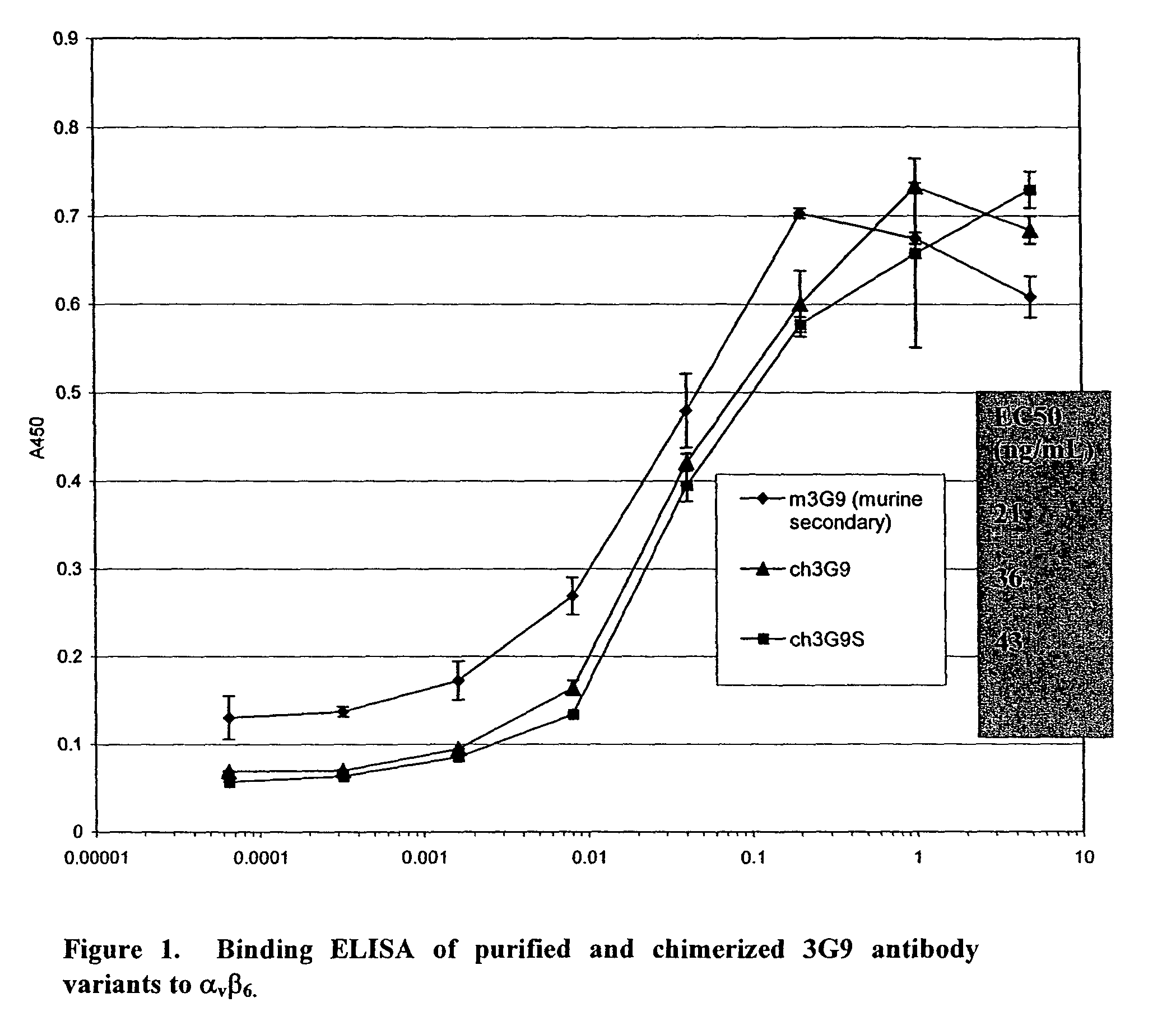Anti-αvβ6 antibodies and uses thereof
a technology of antibody and antigen, applied in the field of cell biology, immunology and oncology, can solve the problems of reducing antibody binding to its antigen, affecting the immunological response of a substantial fraction of patients, and requiring rather extensive experimental data, so as to improve affinity or potency, increase affinity or avidity, and reduce the frequency of adverse effects
- Summary
- Abstract
- Description
- Claims
- Application Information
AI Technical Summary
Benefits of technology
Problems solved by technology
Method used
Image
Examples
example 1
Cloning of the mu3G9 Variable Regions
[0261]Total cellular RNA from 3G9 murine hybridoma cells was prepared using the Qiagen RNeasy mini kit following the manufacturer's recommended protocol. Complementary DNA encoding the variable regions of the heavy and light chains were cloned by RT-PCR from total cellular RNA using the Amersham / Pharmacia First Strand cDNA Synthesis kit following the manufacturer's recommended protocol using random hexamers for priming.
[0262]The primers used for PCR amplification of the murine 3G9 immunoglobulin heavy chain variable domain were:
[0263]
(SEQ ID NO: 8)5′ AGGTCTAGAAYCTCCACACACAGGRRCCAGTGGATAGAC 3′;(SEQ ID NO: 9)5′ GGGGATATCCACCATGRACTTCGGGYTGAGCTKGGTTTT 3′;(S = C / G, M = A / C, R = A / G, K = G / T, W = A / T,and Y = C / T).
[0264]The reaction consisted of an initial melt at 95° C. for 2.5 minutes followed by 10 cycles of melting at 94° C. for 30 seconds, annealing at 60° C. minus 1° C. per cycle for 45 seconds, and elongation at 68° C. for 1 minute using Clontec...
example 2
Construction and Expression of ch3G9
[0269]cDNAs encoding the murine 3G9 variable regions of the heavy and light chains were used to construct vectors for expression of murine-human chimeras (ch3G9) in which the mu3G9 variable regions were linked to human IgG1 and kappa constant regions.
[0270]For construction of the heavy chain chimera, the 508 bp EcoRI fragment from the 3G9 heavy chain variable domain plasmid pKJ062 was subcloned into the EcoRI site of the linearized dephosphorylated pUC-derived cloning vector pNN09. This step added flanking NotI sites in the resulting plasmid, pKJS093. The heavy chain sequence in plasmid pKJS093 was confirmed by DNA sequencing. A splice donor site followed immediately by a HindIII restriction site was added to plasmid pKJS093 just downstream of the variable region coding sequence by site directed mutagenesis with mutagenic oligonucleotides:
[0271]
(SEQ ID NO: 12)5′ CTGTCTCTGCAGGTAAGCTTACACCCCCATCTG 3′,(SEQ ID NO: 13)5′ CAGATGGGGGTGTAAGCTTACCTGCAGAGAC...
example 3
Construction of the hu3G9 Versions 1, 2 & 3
[0277]Design of the reshaped variable domains to produce humanized 3G9 (hu3G9) was done as follows. The 3G9 light chain variable domain corresponds to human kappa 3, and the heavy chain variable domain to human heavy subgroup 3. The choice of the human acceptor frameworks was by homology matching to human germline sequences using the program IgBLAST: human L6 (with the J region derived from human JK4) for the light chain, and human 3-7 (with the J region derived from human JH4) for the heavy chain. Three versions of each of the variable light and heavy reshaped chains were designed, as shown in Table 1. The first version contains the most backmutations to the murine donor sequences, while the third version contains the fewest (i.e., the most “humanized”). The CDR regions of the heavy and light chain variable domains as shown in Table 1 below are being defined by the conventional Kabat numbering classification system. However, the numbering ...
PUM
 Login to View More
Login to View More Abstract
Description
Claims
Application Information
 Login to View More
Login to View More - R&D
- Intellectual Property
- Life Sciences
- Materials
- Tech Scout
- Unparalleled Data Quality
- Higher Quality Content
- 60% Fewer Hallucinations
Browse by: Latest US Patents, China's latest patents, Technical Efficacy Thesaurus, Application Domain, Technology Topic, Popular Technical Reports.
© 2025 PatSnap. All rights reserved.Legal|Privacy policy|Modern Slavery Act Transparency Statement|Sitemap|About US| Contact US: help@patsnap.com



